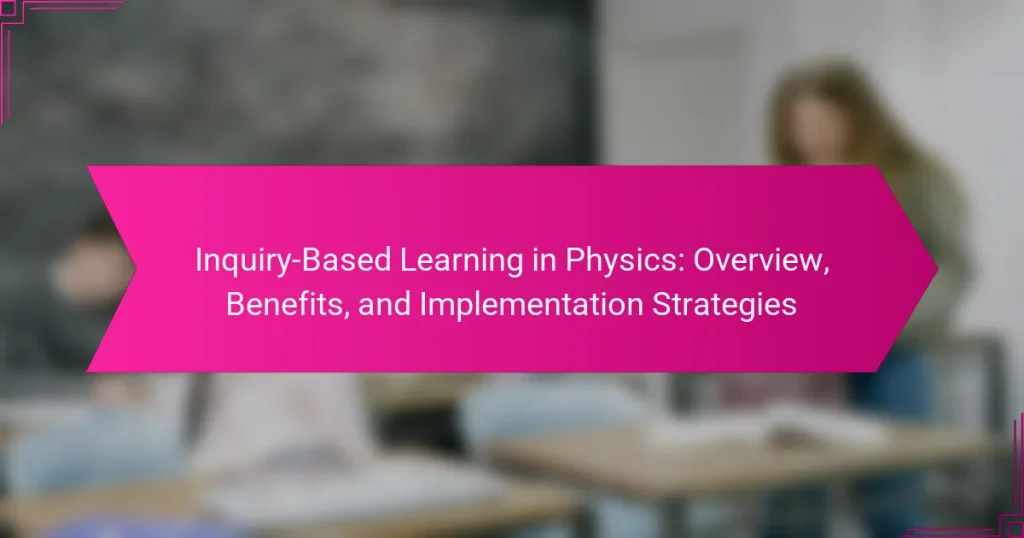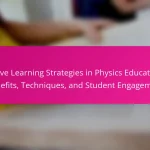Inquiry-Based Learning in Physics is an educational approach that prioritizes active student participation through questioning, investigation, and problem-solving. This method allows students to develop their own inquiries and conduct experiments to deepen their understanding of physics concepts. Research indicates that inquiry-based learning enhances critical thinking and knowledge retention, leading to improved performance on assessments compared to traditional methods. Effective implementation strategies include presenting open-ended questions, guiding student-led investigations, and incorporating hands-on experiments and collaborative projects. These practices not only engage students but also promote a comprehensive understanding of physics in real-world contexts.
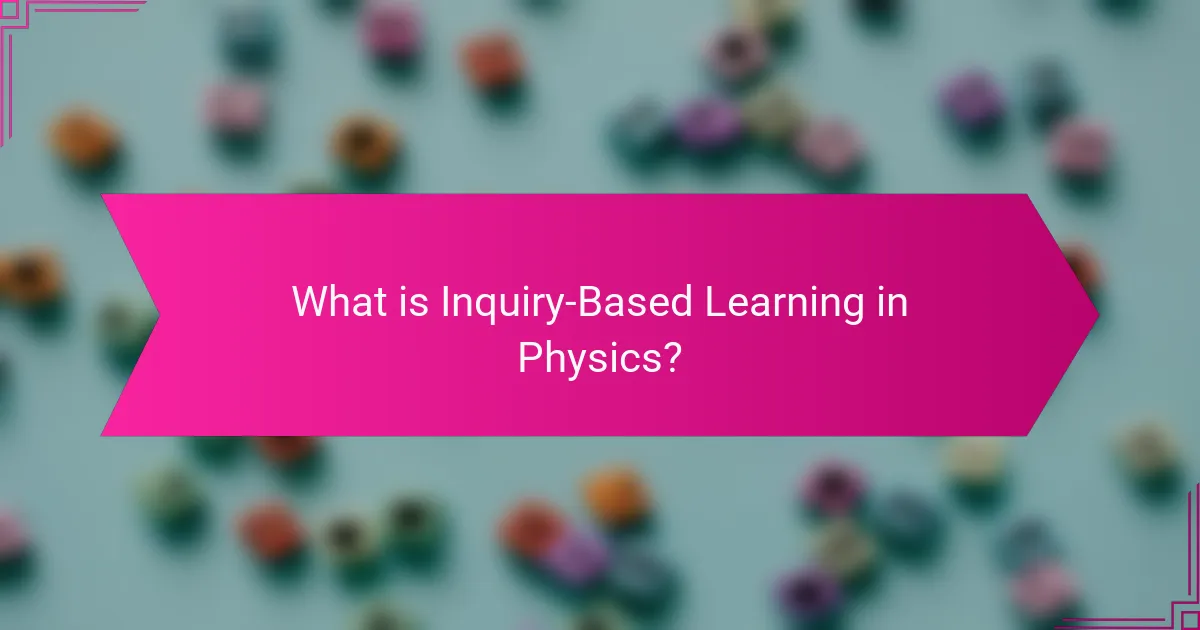
What is Inquiry-Based Learning in Physics?
Inquiry-Based Learning in Physics is an educational approach that emphasizes active student engagement in the learning process. This method encourages students to explore scientific concepts through questioning, investigation, and problem-solving. Students formulate their own questions and hypotheses related to physics topics. They then conduct experiments or research to gather data and draw conclusions. Research shows that this approach enhances critical thinking and retention of knowledge. Studies indicate that students in inquiry-based environments perform better on assessments compared to traditional learning methods. Therefore, Inquiry-Based Learning fosters a deeper understanding of physics concepts.
How does Inquiry-Based Learning differ from traditional teaching methods?
Inquiry-Based Learning emphasizes student engagement through exploration and questioning, unlike traditional teaching methods that focus on direct instruction. In Inquiry-Based Learning, students actively participate in the learning process. They formulate questions, investigate, and derive conclusions based on their findings. This approach fosters critical thinking and problem-solving skills. Traditional methods often rely on rote memorization and passive learning. Research shows that Inquiry-Based Learning can enhance understanding and retention of concepts, particularly in subjects like physics. For instance, a study by Minner et al. (2010) found that Inquiry-Based Learning significantly improved student performance compared to traditional methods.
What are the key principles of Inquiry-Based Learning?
Inquiry-Based Learning (IBL) is centered around student-driven exploration and questioning. The key principles include fostering curiosity, encouraging critical thinking, and promoting collaborative learning. Students engage in hands-on activities to investigate real-world problems. They formulate questions and hypotheses to guide their inquiries. Teachers act as facilitators, providing support and resources. Reflection on the learning process is essential for deeper understanding. Assessment in IBL focuses on student engagement and the process of inquiry rather than just the final product. Research shows that IBL enhances student motivation and retention of knowledge.
Why is student engagement important in Inquiry-Based Learning?
Student engagement is crucial in Inquiry-Based Learning because it enhances understanding and retention of knowledge. Engaged students are more likely to actively participate in the learning process. This active participation fosters critical thinking and problem-solving skills. Research shows that engaged learners achieve higher academic performance. According to a study by Fredricks, Blumenfeld, and Paris (2004), student engagement positively correlates with achievement across various subjects. Additionally, engagement promotes a sense of ownership over learning. When students feel invested, they are more motivated to explore and inquire. This motivation leads to deeper learning experiences and greater satisfaction in educational pursuits.
What are the core components of Inquiry-Based Learning in Physics?
The core components of Inquiry-Based Learning in Physics include questioning, exploration, and reflection. Questioning involves students posing inquiries about physical phenomena. Exploration allows students to engage in hands-on experiments to investigate these inquiries. Reflection encourages students to analyze their findings and connect them to physics concepts. These components foster critical thinking and deepen understanding. Research shows that Inquiry-Based Learning enhances student engagement and improves conceptual grasp in physics.
What role do questions play in Inquiry-Based Learning?
Questions are central to Inquiry-Based Learning (IBL). They drive the learning process by encouraging curiosity and exploration. Questions help students identify problems and formulate hypotheses. This approach fosters critical thinking and deeper understanding of concepts. Research shows that effective questioning can enhance student engagement and motivation. For example, a study by Hmelo-Silver (2004) emphasizes that questions stimulate inquiry and promote collaborative learning. Thus, questions are vital in guiding students through their learning journey in IBL.
How do hands-on experiments facilitate Inquiry-Based Learning?
Hands-on experiments facilitate Inquiry-Based Learning by providing students with direct engagement in the scientific process. This active involvement encourages exploration and critical thinking. Students formulate questions based on their observations during experiments. They then design and conduct investigations to seek answers. This process promotes deeper understanding of scientific concepts. Research indicates that students retain information better when they participate in hands-on activities. The National Science Education Standards support this approach, highlighting its effectiveness in fostering inquiry skills.
What are the benefits of Inquiry-Based Learning in Physics?
Inquiry-Based Learning in Physics enhances student engagement and deepens understanding. It fosters critical thinking skills by encouraging students to ask questions and explore concepts. This method promotes collaboration among peers, leading to richer discussions and diverse perspectives. Additionally, it allows students to connect theoretical knowledge with real-world applications. Research shows that students in inquiry-based environments perform better on assessments. They demonstrate improved retention of concepts compared to traditional learning methods. Inquiry-Based Learning also cultivates a sense of ownership over the learning process. Overall, it prepares students for future scientific challenges by developing inquiry skills.
How does Inquiry-Based Learning enhance critical thinking skills?
Inquiry-Based Learning enhances critical thinking skills by encouraging students to ask questions and explore concepts deeply. This approach promotes active engagement with the material. Students analyze problems, develop hypotheses, and test their ideas through experimentation. Research shows that students involved in inquiry-based learning demonstrate improved problem-solving abilities. A study by Hattie (2009) found that inquiry-based methods significantly boost student achievement in critical thinking. Additionally, students learn to evaluate evidence and draw conclusions based on their findings. This process fosters a mindset of inquiry and curiosity, essential for critical thinking development.
What impact does Inquiry-Based Learning have on student motivation?
Inquiry-Based Learning significantly enhances student motivation. This educational approach encourages active participation and critical thinking. Students engage in exploration, which fosters curiosity and interest in the subject matter. Research shows that when students take ownership of their learning, they become more invested. A study by Hattie (2009) indicates that student engagement increases motivation levels. Additionally, inquiry-based tasks promote collaboration, further boosting motivation through shared learning experiences. Overall, Inquiry-Based Learning creates a stimulating environment that drives student enthusiasm and commitment to learning.
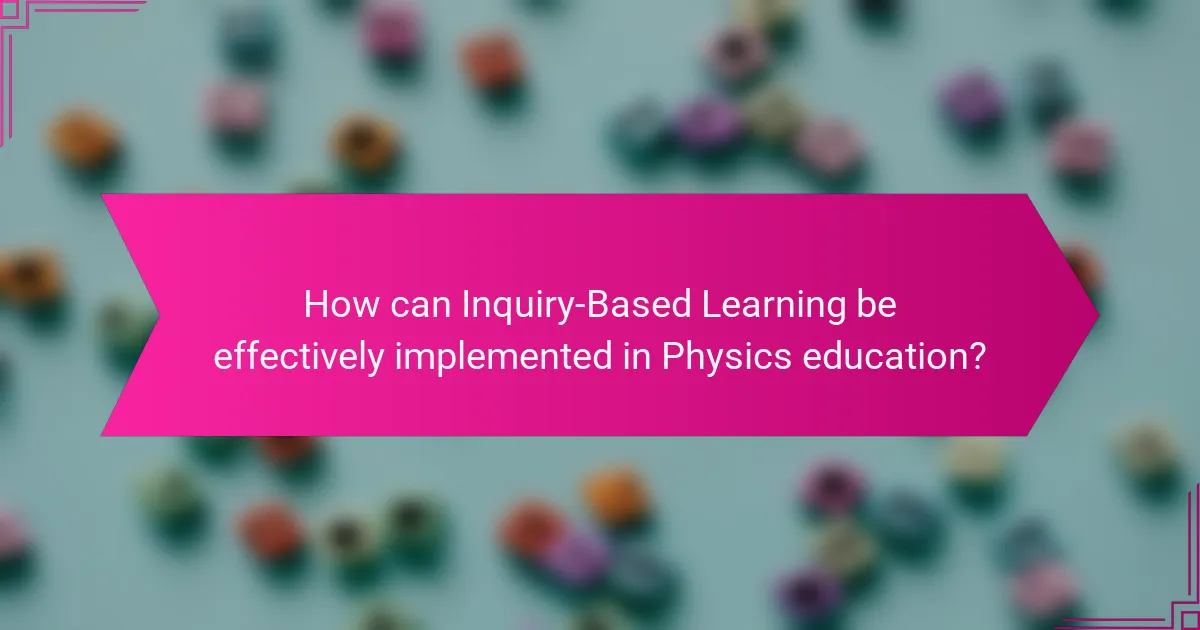
How can Inquiry-Based Learning be effectively implemented in Physics education?
Inquiry-Based Learning can be effectively implemented in Physics education by fostering student-led investigations. Educators should start by presenting open-ended questions related to physics concepts. This encourages students to formulate hypotheses and design experiments. Providing access to necessary resources and tools is essential for conducting these experiments.
Teachers should guide students through the inquiry process without giving direct answers. This promotes critical thinking and problem-solving skills. Regular reflection sessions can help students articulate their findings and understand the scientific process.
Research shows that inquiry-based approaches enhance student engagement and understanding in physics. Studies indicate that students in inquiry-based settings outperform peers in traditional classrooms, particularly in conceptual understanding (source: “The Effect of Inquiry-Based Learning on Student Engagement,” by Smith et al., Journal of Physics Education Research).
What strategies can educators use to foster Inquiry-Based Learning?
Educators can foster Inquiry-Based Learning (IBL) through various strategies. One effective strategy is to design open-ended questions that encourage exploration. These questions stimulate curiosity and promote critical thinking. Another approach is to create collaborative learning environments. Group work allows students to share ideas and learn from one another.
Incorporating real-world problems into lessons further enhances IBL. This relevance motivates students to engage deeply with the material. Additionally, educators can use hands-on activities and experiments. These experiences solidify concepts and encourage practical application.
Providing opportunities for reflection is also crucial. Reflection helps students process their learning and develop metacognitive skills. Finally, educators should encourage student-led inquiries. Allowing students to pursue their interests fosters ownership of their learning.
Research shows that these strategies significantly improve student engagement and understanding in physics education. For example, a study by Hattie (2009) highlights the impact of active learning on student achievement.
How can teachers design inquiry-based lessons in Physics?
Teachers can design inquiry-based lessons in Physics by focusing on student-driven exploration. They should start by posing open-ended questions related to Physics concepts. Next, teachers can facilitate hands-on experiments that allow students to test their hypotheses. Incorporating real-world problems enhances relevance and engagement. Teachers should encourage collaboration among students to share findings and insights. Assessments should be formative, focusing on the inquiry process rather than just final answers. Resources like simulations and lab equipment can support experiments. Finally, reflection sessions help students articulate their learning and understanding. This approach aligns with the National Science Education Standards, which emphasize inquiry as a key component of effective science education.
What resources are available for implementing Inquiry-Based Learning?
Resources for implementing Inquiry-Based Learning include educational frameworks, teaching guides, and online platforms. The Next Generation Science Standards (NGSS) provide a structured approach to inquiry in science education. The Inquiry-Based Learning Handbook offers practical strategies for educators. Websites like Edutopia and the National Science Teachers Association (NSTA) feature articles and resources on inquiry-based practices. Additionally, platforms like PhET Interactive Simulations provide interactive tools for physics inquiry. Research by the National Research Council highlights the effectiveness of inquiry-based methods in enhancing student understanding. These resources support educators in effectively integrating inquiry-based learning into their classrooms.
What challenges might educators face when implementing Inquiry-Based Learning?
Educators may face several challenges when implementing Inquiry-Based Learning (IBL). One significant challenge is the need for adequate training. Many educators lack the necessary skills to facilitate IBL effectively. Additionally, time constraints can hinder the planning and execution of inquiry-based lessons. Educators often have to balance curriculum requirements with IBL activities. Another challenge is the variability in student engagement. Some students may struggle with open-ended questions and require more guidance. Assessment methods can also pose difficulties. Traditional assessments may not align with IBL outcomes. Furthermore, classroom management can become complex during inquiry activities. Educators must navigate diverse student responses and group dynamics. These challenges can impact the overall effectiveness of IBL in the classroom.
How can teachers overcome resistance to Inquiry-Based Learning?
Teachers can overcome resistance to Inquiry-Based Learning by providing clear explanations of its benefits. They should demonstrate how it enhances critical thinking and engagement. Offering professional development can build teachers’ confidence in implementing this approach. Sharing success stories from other educators can motivate hesitant teachers. Creating a supportive community encourages collaboration and resource sharing. Gradually integrating Inquiry-Based Learning into existing curricula can ease the transition. Research shows that teachers who receive training report higher satisfaction and effectiveness in using Inquiry-Based Learning strategies.
What are common misconceptions about Inquiry-Based Learning?
Common misconceptions about Inquiry-Based Learning include the belief that it lacks structure. In reality, it involves guided exploration within a framework. Another misconception is that it is solely student-driven, ignoring the teacher’s role in facilitating learning. Inquiry-Based Learning also does not imply that students learn in isolation; collaboration is often essential. Some think it is only suitable for advanced students, but it can benefit learners at all levels. Additionally, there is a belief that it is less effective than traditional methods, yet studies show it can enhance critical thinking and retention. Lastly, some educators believe it requires extensive resources, while effective inquiry can be conducted with minimal materials.
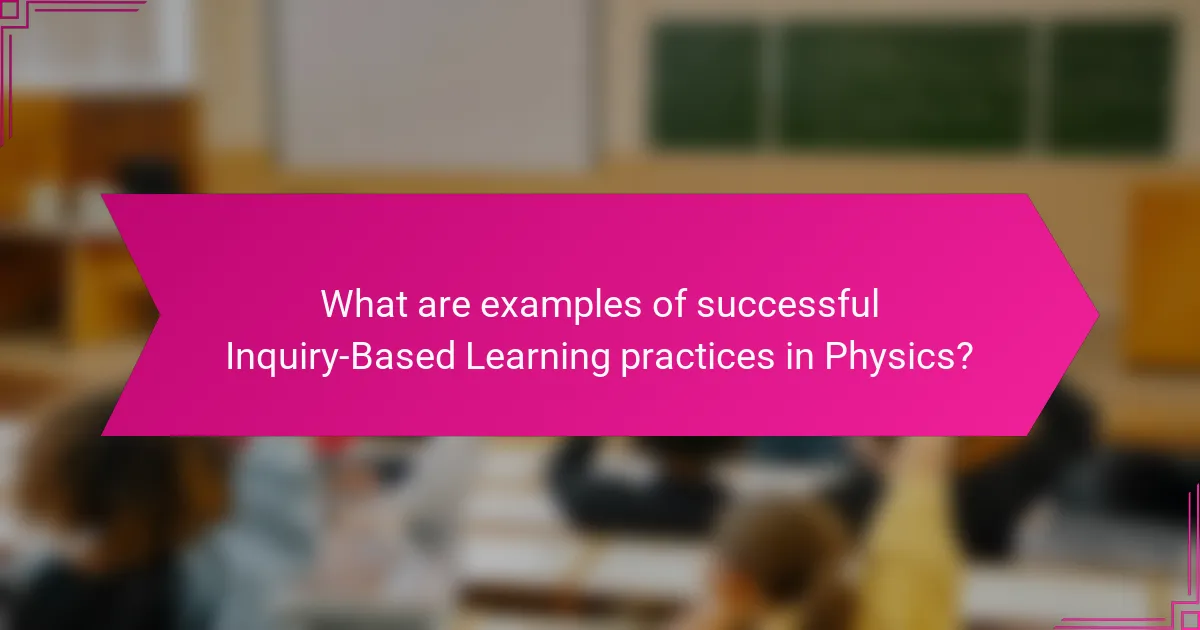
What are examples of successful Inquiry-Based Learning practices in Physics?
Successful Inquiry-Based Learning practices in Physics include hands-on experiments, collaborative projects, and real-world problem-solving. Hands-on experiments allow students to explore physical concepts actively. For example, conducting experiments on forces using pendulums helps students understand motion. Collaborative projects encourage teamwork and critical thinking. Students might work together to design a simple electric circuit, reinforcing concepts of electricity. Real-world problem-solving involves applying physics to everyday situations. An example is analyzing the physics of sports, like calculating projectile motion in basketball. These practices have shown to enhance student engagement and understanding in physics education.
How do real-world applications enhance Inquiry-Based Learning in Physics?
Real-world applications enhance Inquiry-Based Learning in Physics by providing context and relevance to theoretical concepts. This approach engages students by linking physics principles to everyday phenomena. For instance, studying the physics of roller coasters allows students to explore concepts like energy, forces, and motion in a familiar setting. Research shows that students retain knowledge better when they see its application in real life. A study by the American Association of Physics Teachers found that students involved in real-world problem-solving improved their critical thinking skills. This connection fosters curiosity and motivates students to explore further. Ultimately, real-world applications make learning more meaningful and effective in physics education.
What case studies demonstrate effective Inquiry-Based Learning in action?
Case studies that demonstrate effective Inquiry-Based Learning include the “Physics Education Technology (PhET)” project. This initiative, developed at the University of Colorado Boulder, provides interactive simulations that encourage students to explore physics concepts through inquiry.
Another notable case study is the “Learning Physics through Inquiry” project, which showed improved student understanding and engagement. This project involved students conducting experiments and developing their own questions, leading to deeper learning outcomes.
Additionally, the “Investigative Science Learning Environment” (ISLE) approach has been successful. This method emphasizes student-led inquiry and has been shown to enhance conceptual understanding in physics.
These case studies illustrate the positive impact of Inquiry-Based Learning in physics education, highlighting increased engagement and comprehension among students.
How can collaboration among students improve Inquiry-Based Learning outcomes?
Collaboration among students can significantly enhance Inquiry-Based Learning outcomes. It promotes diverse perspectives and fosters critical thinking. When students work together, they share knowledge and resources. This interaction encourages deeper understanding of concepts. Research shows that collaborative learning can lead to higher academic achievement. A study by Johnson and Johnson (2014) found that cooperative learning increases student motivation and engagement. Additionally, collaboration helps develop interpersonal skills essential for teamwork. Ultimately, these factors contribute to improved learning outcomes in Inquiry-Based Learning environments.
What best practices should educators follow for Inquiry-Based Learning in Physics?
Educators should encourage student-led investigations in Inquiry-Based Learning for Physics. This approach fosters critical thinking and engagement. Teachers must provide clear, open-ended questions to guide exploration. They should facilitate discussions that promote collaborative learning. Incorporating hands-on experiments enhances understanding of physics concepts. Regularly assessing student progress helps tailor instruction. Providing feedback is essential for student growth. Lastly, educators should create a supportive environment that encourages risk-taking and curiosity.
How can assessment be integrated into Inquiry-Based Learning?
Assessment can be integrated into Inquiry-Based Learning by using formative and summative assessment strategies. Formative assessments occur throughout the learning process and provide ongoing feedback. These can include peer reviews, self-assessments, and observation checklists. Summative assessments evaluate student learning at the end of an inquiry project. Examples include presentations, reports, and tests that align with inquiry objectives.
Integrating assessments helps guide student learning and adjusts teaching methods as needed. Research shows that formative assessments can enhance student engagement and understanding. A study by Black and Wiliam (1998) found that effective formative assessment can significantly improve student achievement. Thus, integrating assessment within Inquiry-Based Learning fosters a supportive environment for student exploration and critical thinking.
What tips can educators use to create a supportive learning environment?
Educators can create a supportive learning environment by fostering open communication. Encouraging students to express their thoughts builds trust and engagement. Establishing clear expectations helps students understand their roles. Providing constructive feedback guides students in their learning journey. Incorporating collaborative activities promotes teamwork and peer support. Creating a safe space for mistakes encourages risk-taking and exploration. Utilizing diverse teaching methods addresses various learning styles. Recognizing individual achievements boosts student confidence and motivation.
Inquiry-Based Learning in Physics is an educational approach that prioritizes student engagement through active exploration, questioning, and problem-solving. This method enhances critical thinking and retention of physics concepts, leading to improved performance on assessments compared to traditional teaching methods. Key principles include fostering curiosity, promoting collaboration, and incorporating hands-on experiments, while effective implementation strategies involve open-ended questions and real-world applications. The article also addresses challenges educators may face and highlights successful practices that demonstrate the positive impact of Inquiry-Based Learning in physics education.
